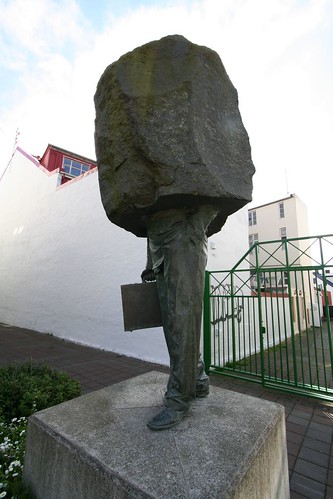Eastern Europe: Parties and the mirage of technocracy
By Sean L Hanley, on 16 May 2013

Image: kerryj.com CC-BY-NC
Non-party technocratic governments of experts have stepped in to fill a political gap in several European countries. But in East and Central Europe they are not always what they seem, writes Seán Hanley
Many commentators saw the governments of non-party technocrats formed in Greece and Italy in 2011 as an ill omen for development of party-based democracy in Europe. Established parties, it is suggested, are turning to technocratic caretaker administrations as a device to manage economic and political crisis, which allows them both to duck (or least share) responsibility for painful austerity measures. Such non-partisan governments of experts, it is argued, can only widen the yawning the legitimacy gap between governors and governed.
Technocratically-imposed austerity backed by big established parties can further undermine party democracy by provoking anti-elite electoral backlashes: the rise of new populist parties or breakthroughs by previously marginal radical groups. This in turn, makes coalition formation difficult and further rounds of caretaker government or awkward left-right co-operation more likely. The success of the Five Star Movement in Italy and its difficult political aftermath, which has finally resulted in an implausible Grand Coalition, seems to illustrate this scenario perfectly. Sometimes, caretaker technocrats themselves even add to the uncertainty, revolting against their erstwhile masters and founding their own new parties.
How has the drift towards technocratic crisis management impacted Central and Eastern Europe? The region is sometimes grouped with debt- and crisis-afflicted Southern Europe states as an economically weak periphery of flawed and potentially unstable democracies, where technocratic crisis governments are the order of the day.
And not without reason. In March this year the President of Bulgaria Rosen Plevneliev appointed a technocratic caretaker government to lead the country to early elections on 12 May following the resignation of prime minister Boyko Borisov in the face of street protests against poverty, high utility prices and corruption. Hungary had a year-long technocrat-led government in 2009-11, as did the Czech Republic in 2009-10 following the fall the centre-right minority government of Miroslav Topolánek. Meanwhile, Slovenia – one of three CEE states in the Eurozone – is set for a Southern European-style bailout following the downgrading of its bonds to junk status with undoubted domestic ramifications.
In fact, however, as in Western Europe technocrat-led caretaker governments are something of a rarity in Central and Eastern Europe. Other than the Czech, Bulgarian and Hungarian cases, potential examples are confined to episodes in the immediate post-transition period of the early-mid 1990s. The image of technocrats emerging deus ex machina from ministries and international organisations to relieve a shattered, discredited party establishment is also misleading. While parties in the region are increasingly embattled, technocratic caretaker administrations often seem as much as a tactic to buy time and placate angry electorate and ensure business as usual than a threat to party government per se.
In some instances this is self-evident. Hungary’s Gordon Bajnai had been a minister in outgoing Socialist-led government and led a semi-political administration, which included Socialist ministers as well as non-party experts and which drew parliamentary supported in parliament only by parties of the liberal left. In other cases the pattern is more subtle. The ‘government of experts’ installed by the Czech Republic’s two main rival parties in 2009 to steer the country down the constitutionally tricky path to early elections seems at first archetypically technocratic: the caretaker prime minister was the previously obscure head of the Czech Statistical Office Jan Fischer and neither he nor any of the civil servants and public managers appointed as ministers were party members.
Closer examination, however, shows a somewhat different picture. Around a third of Fischer’s cabinet had close ties with the party that nominated them. A few were party members, who simply resigned their party membership on joining the government and resumed it after leaving. Several had stood for national elected office, pursuing on-off political involvement in parallel with careers in public administration. In other cases, links were looser and more informal, but nevertheless real.
Such partisan ties do not mean that caretaker non-political administrations are mere puppets. Even the grey and seemingly unassertive Fischer sought from the outset to slip the lease of party control imposed on his government. But they do highlight the in some newer European democracies to rethink assumptions about the divide between party politicians and their technocratic replacements.
In such systems the boundaries between top-level public administration and party structures are fluid and blurred: while formally traditional membership organisations, parties are de facto more loose elite networks, which routinely use partisan appointment to public bodies to enhance their political control and, conversely, seek to bring high-ranking public officials into party organisations chronically lacking well qualified policy specialists.
In such a context the ideal of non-partisan neutral technocratic government standing above – and against – parties is often more important than the reality. Indeed, it is striking that the national contexts where technocratic caretakers governments have so far emerged (Greece, Italy, Czech Republic, Bulgaria), are precisely those where public administration and the (top level) state apparatus is more subject to party patronage and predation by informal networks.
Seán Hanley is a Senior Lecturer in East European Politics at UCL-SSEES. His research focuses on the rise of anti-establishment parties and anti-political challenges to party-based democracy in Europe. This post draws on a paper presented at the EUSA conference in Baltimore 9 – 11 May examining the 2009-10 Fischer government in the Czech Republic.
Note: This article gives the views of the author(s), and not the position of the SSEES Research blog, nor of the School of Slavonic and East European Studies, nor of UCL.
 Close
Close


